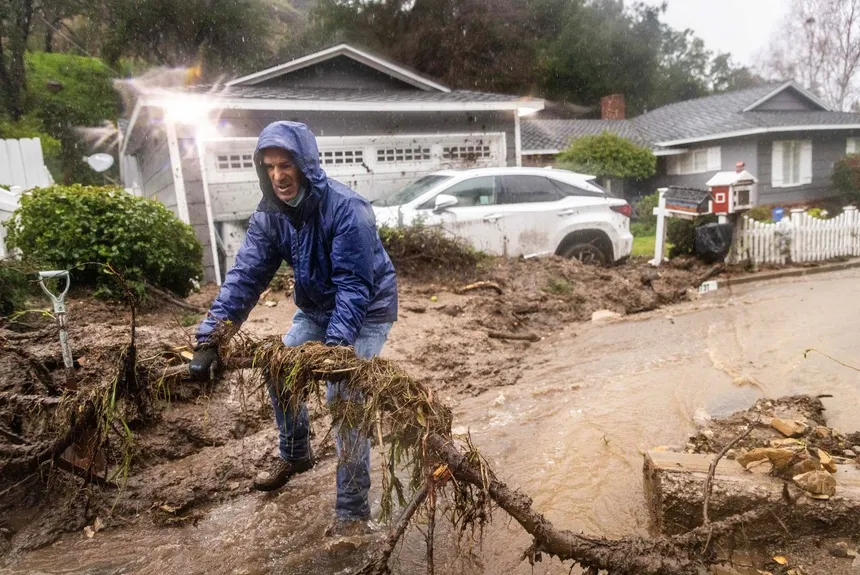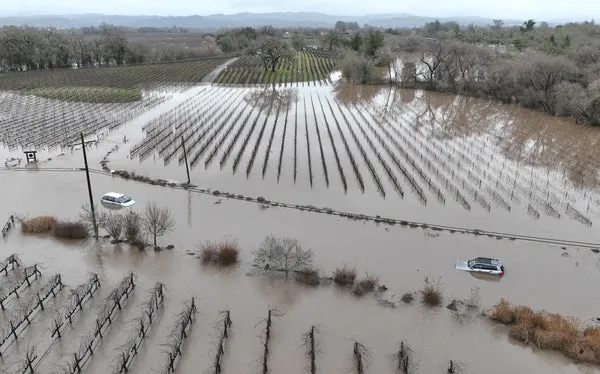California’s inhabitants are breathing a sigh of relief after the state’s 11th atmospheric river delivered a rare bout of drought-busting rainfall, bringing an end to water restrictions for nearly 7 million people. The restrictions, imposed due to severe water shortages, had limited activities such as outdoor watering. However, the state is still reeling from the aftermath of the most recent storm, which has caused a range of problems.
Thousands of residents remain under evacuation warnings or without power, with flooding closing several miles of the Pacific Coast Highway. In Orange county, dramatic drone footage showed saturated hillsides along the coast that crumbled, leaving homes precariously perched on newly created cliffs. Governor Gavin Newsom noted that California could potentially see a 12th atmospheric river next week, further highlighting the state’s precarious weather situation.
Newsom reinforced the severity of the storm, stating, “Look back – last few years in this state, it’s been fire to ice with no warm bath in between.” He emphasized that California could potentially see more extreme weather events due to the changing climate. The governor added, “If anyone has any doubt about Mother Nature and her fury, if anyone has any doubt about what this is all about in terms of what’s happening to the climate and the changes that we are experiencing, come to California.”
The state’s water infrastructure has indeed been severely tested. Runoff from a powerful atmospheric river last week burst a levee on the Pajaro River, triggering evacuations and flooding farmland and agricultural communities. The first phase of repairs on the 400ft levee breach was completed Tuesday afternoon, with crews working to raise the section to full height.

In Orange county, four apartment buildings were evacuated and red-tagged after the bluff gave way behind them, burying parts of the famous Pacific Coast Highway under mud and trees, forcing closures. Engorged rivers have also caused calamity in California’s Central Valley, prompting evacuation warnings in Plumas county and orders in Tulare county.
However, the downpours have also delivered relief, with engorged reservoirs and an enormous snowpack that was 223% of normal as of Thursday. The water content of the Sierra snow is now more than 200% of the 1 April average, ensuring the state will have moisture to count on as the weather warms. The metropolitan water district of southern California’s decision to end restrictions on Wednesday came as a welcome sign that water woes in Los Angeles, Ventura, and San Bernardino counties may be subsiding – at least for now – even as residents struggled to clean up before fresh storms arrive.
For downtown Los Angeles, the National Weather Service said just under 2ft of rain had been recorded so far this water year, making this the 14th wettest in more than 140 years of records. California’s latest atmospheric river was one of two storm systems that bookended the US this week, with other parts of the country experiencing extreme winter weather throughout the season.
As areas across the west prepare for even more wet weather, officials are hopeful that waterlogged residents remember: the drought is not yet over. In California, it is clear that the state will swing back into dry times again. Michael McNutt, a spokesperson for the Las Virgenes municipal water district, stated, “We all know that the next drought is just around the corner. We’ve got to treat the water coming out of our taps as the liquid gold that it is.”

